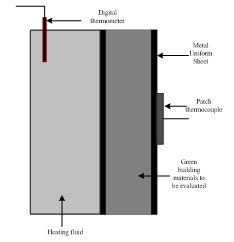
Green building materials are an important material basis for promoting the development of green buildings, and also the foundation of building energy conservation. In view of this, an insulation effect evaluation model of green building materials is constructed. The outer wall temperature index, the equivalent thermal resistance index, the inner surface maximum temperature and the thermal inertia index are used to characterize the insulation effect of the green building materials. According to the insulation effect evaluation principle of green building materials, the outer surface and inner surface temperature deviation curves and its’ fitting curves are made. The integral area between the fitting curve and the standard line is the temperature factor. The temperature factor can be used as an evaluation parameter for the insulation effect of green building materials in a fixed temperature range. It can characterize the average insulation effect of green building materials under a certain temperature range and comprehensive evaluation of different characterization indicators. The greater the temperature factor value is, the better the insulation effect is. The experimental results show that the model can accurately reflect the overall insulation effect of green building materials under the influence of various indicators in a certain temperature range, and the evaluation accuracy is high.
Total file downloads: 5